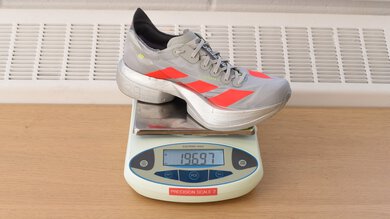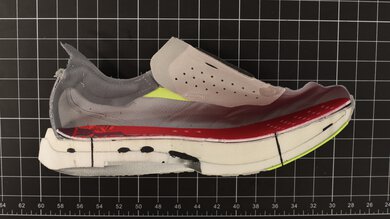
Finding the best running shoes can feel like an uphill race, whether you're an experienced marathoner chasing the latest in footwear innovation or simply seeking a reliable and comfortable option for daily training. With countless models boasting various features, narrowing down the best choice for your unique needs can seem overwhelming. However, understanding your priorities—like cushioning, stability, or raw speed—can make all the difference in choosing the ideal pair.
We've tested over 40 models; below are our recommendations for the top running shoes you can buy.
-
Best Running Shoe For Racing
Marathon Racing8.55K/10K Racing8.2Performance Usages: Energy Return8.8Cushioning8.8Lateral Stability5.6The best running shoes for racing are the adidas Adizero Adios Pro 4, offering an impressive mix of cushioning and bounce that make them the go-to choice when the gun goes off. Its premium midsole foam and carbon energy rods deliver a bouncy yet controlled ride that stays effective even deep into a marathon. If you're looking for a fast, responsive shoe that won't beat up your legs over 42K, this is it.
If you're racing shorter events or want something more nimble, the Nike Vaporfly 4 is a strong alternative. It's incredibly light and delivers a firm, direct ride that feels fast and efficient off the ground. The lower stack height offers a closer-to-the-ground sensation and a snappy toe-off, which many runners will appreciate in 5Ks, 10Ks, or even half-marathons. That said, it doesn't offer as much protection for longer efforts and can feel harsh late into a race, making the Adios Pro 4 the better pick for full-distance events.
Like most super shoes, both the adidas and Nike shoes prioritize optimal performance at the expense of stability and long-term durability.
-
Most Versatile Running Shoe
Marathon Racing6.55K/10K Racing6.2Performance Usages: Energy Return7.1Cushioning8.2Lateral Stability7.5The ASICS SUPERBLAST 2 is the shoe to reach for if you want a versatile trainer that effortlessly tackles nearly every type of run. Its dual-layer midsole—featuring a plush top layer and a supportive, firmer foam beneath—delivers an impressive combination of comfort, responsiveness, and stability. Despite lacking a plate, this shoe transitions seamlessly between easy-paced training, steady long runs, and even faster workouts, making it one of the most adaptable shoes we've tested.
Another great pick is the adidas Adizero Evo SL, an uptempo trainer that maximizes value without sacrificing performance. It's a lightweight, versatile shoe with elite features such as adidas' premium foam usually reserved for super shoes. It offers excellent energy return and responsive cushioning, making it versatile enough to handle anything from daily jogs to race-day efforts—though it truly shines during uptempo intervals, delivering a dynamic and lively ride. That said, this shoe will feel harsher for easy paces and longer runs than the more protective ASICS shoe, which offers superior cushioning and a higher stack height.
While these two unplated options don't have the aggressive feel of dedicated super shoes like the adidas Adizero Adios Pro 4, their excellent cushioning and good energy return mean they can comfortably handle your occasional local event. However, they aren't a top-of-the-line option for elite racing.
-
Most Cushioned Running Shoe
Marathon Racing6.85K/10K Racing6.3Performance Usages: Energy Return7.1Cushioning8.9Lateral Stability6.8The Mizuno Neo Zen is the shoe to grab when your legs are tired, but you still need to log those recovery runs. Its generous cushioning provides a plush feel that's great for shorter daily runs, particularly on days when you don't want to go fast and just want maximum comfort. Featuring a supercritical midsole, it's a modern daily trainer that ensures a smooth, protective ride. Unfortunately, it's a bit too soft and bulky to handle uptempo efforts with ease.
For runners wanting a max-cushioned, ultra-high stack shoe that doesn't feel too sluggish, the HOKA Mach X 2 is an excellent alternative that can handle faster sessions more effortlessly than the Mizuno. As a plated super trainer, it provides plush comfort without sacrificing responsiveness, so you can comfortably pick up the pace when you feel like pushing it. If you need something more comfortable for easier paces, go with the Mizuno, but for those speedier sessions, get the HOKA.
-
Best Long Run Running Shoe
Marathon Racing6.55K/10K Racing6.2Performance Usages: Energy Return7.0Cushioning8.5Lateral Stability7.4The ASICS NOVABLAST 5 is our top pick for training long runs where comfort and reliable protection are essential. It offers excellent cushioning that stays consistently comfortable over extended runs and is paired with a midsole that provides decent energy return, allowing you to comfortably shift gears during these long sessions.
It's a bit less cushioned than the Mizuno Neo Zen, but it's lighter and still very protective, making it easy on your legs even deep into long distances. With its well-balanced design and smooth ride, this shoe helps you stay fresh and smooth on your longest runs. Compared to a long-distance super shoe like the adidas Adizero Adios Pro 4, the ASICS prioritizes overall comfort and stability for training runs. On the other hand, the adidas shoe emphasizes raw performance on race day through its lighter weight and superior energy return to maximize efficiency. However, it sacrifices some comfort and durability for regular training.
-
Best Running Shoe For Stability
Marathon Racing6.45K/10K Racing7.3Performance Usages: Energy Return6.2Cushioning6.7Lateral Stability8.4The New Balance FuelCell Rebel v4 offers impressive stability, making it ideal for runners who need solid ground feel but don't want to sacrifice too much performance. Its very wide base and lower stack height keep you grounded, which is particularly valuable when fatigue compromises your form. While this shoe doesn't provide dedicated support features, its design naturally delivers excellent lateral stability. The shoe remains surprisingly lightweight and decently cushioned, thanks to its midsole. It also provides a decent bounce, making this a well-rounded pick that goes beyond simply offering reliable stability.
If you need a shoe that actively guides your stride, the ASICS GEL-KAYANO 31 is a support shoe designed to correct overpronation, delivering stability through a structured build. It uses support elements like a soft foam-based block for pronation support that bounces your arch back into alignment. However, this comes at the cost of added weight and reduced responsiveness.
That said, while great stability can be a big plus when form starts to break down, this type of shoe isn't necessarily a great pick for longer efforts. For that, a more protective option with a higher stack—like the ASICS NOVABLAST 5—does a better job.
Notable Mentions
- On Cloudboom Zone:
The On Cloudboom Zone is a stripped-back, unplated trainer built for speed. Its firm midsole and responsive toe-off make it a great match for intervals and tempo sessions, delivering a snappy ride without the rigidity of plated designs. It feels quick and agile, but compared to the adidas Adizero Evo SL, it doesn't offer the same level of cushioning or energy return, so it's a bit less well-rounded.
See our review - Brooks Glycerin Max:
The Brooks Glycerin Max impresses with its amazing comfort. While its midsole doesn't absorb as much impact as the Mizuno Neo Zen or the HOKA Mach X 2, its generous stack height and plush cushioning still deliver a luxurious ride. It's quite heavy, but that's not too bothersome given its ideal use: easy recovery runs.
See our review - Nike Vomero 18:
The Nike Vomero 18 is a no-nonsense daily trainer built for runners who want a cushioned shoe they can rely on day after day. It doesn't try to reinvent anything—it just delivers a solid, protective, and reliable ride. However, compared to the ASICS NOVABLAST 5, it's noticeably heavier and lacks the soft, bouncy ride that makes it a favorite for longer efforts. Still, for runners who value stability, protection, and a no-fuss ride, the Vomero 18 holds its ground.
See our review
Recent Updates
-
We replaced the Nike Alphafly 3 with the adidas Adios Pro 4 as the new racing pick, as it offers better cushioning and improved energy return at a similar weight. We also replaced the On Cloudboom Strike with the Nike Vaporfly 4 as a racing alternative pick to better cover the full racing spectrum, including shorter distances. Finally, we updated the 'Most Cushioned' pick by replacing the Mizuno Neo Vista with the Mizuno Neo Zen, as this newer model provides better underfoot protection.
All Reviews
Our recommendations above are what we think are currently the best shoes for running for most people. We factor in the price (a cheaper pair wins over a pricier one if the difference isn't worth it), feedback from our visitors, and availability (no running shoes that are difficult to find or almost out of stock everywhere).
If you'd prefer to choose for yourself, here's the list of all our running shoe reviews. No shoe is perfect for everyone; your personal preferences, running style, physiology, and training goals will play the biggest role in your selection.
Comments
Best Running Shoes: Main Discussion
What do you think of our picks? Let us know below.
Looking for a personalized buying recommendation from the RTINGS.com experts? Insiders have direct access to buying advice on our insider forum.
Update: We replaced the Nike Alphafly 3 with the adidas Adios Pro 4 as the new racing pick, as it offers better cushioning and improved energy return at a similar weight. We also replaced the On Cloudboom Strike with the Nike Vaporfly 4 as a racing alternative pick to better cover the full racing spectrum, including shorter distances. Finally, we updated the ‘Most Cushioned’ pick by replacing the Mizuno Neo Vista with the Mizuno Neo Zen, as this newer model provides better underfoot protection.
What do you think of these changes? Let us know
- 21010
hi will there eventually be best cheap option, or best all around option ?
Hi! Great question. Yes, we’re planning to expand our recommendation categories over time. While we don’t factor price directly into our test scores (since everything is based on performance), we do consider it indirectly when making recommendations—if a cheaper shoe performs similarly well as a pricier one, that’s something we take into account.
As for a “best all-around” pick, it really depends on personal preferences, but a good all-around shoe should feel comfortable at different paces, handle various types of runs (from easy days to workouts), and work across a range of distances (“one shoe to do it all”). The Most Versatile Running Shoe picks in our list above are essentially that: strong options that perform well across multiple run types and strike a great balance between cushioning, responsiveness, and stability.
- 32120
hi will there eventually be best cheap option, or best all around option ?
- 21010
Any chance of adding a weight for foot support/structure or a new category for “barefoot” shoes?
Hi izzyaudio. I’m curious what you mean by foot support/structure. Do you mean the structure of the shoe and how much support it provides for people who pronate? As for a barefoot category, although I can’t promise anything right now since barefoot isn’t our highest priority, it’s an interesting idea and I’ll add it to our list for future updates.
- 32120
Any chance of adding a weight for foot support/structure or a new category for “barefoot” shoes?
- 43230
Yall are so much better than consumer reports… thank god
- 21010
Love that you added this. Only thing different I would like to see is forefoot energy return as heal strike isn’t great running form, especially at higher speeds/longer distance.
Hi Err19, We actually measure and score both heel and forefoot energy return, so depending on your specific running style you can still evaluate the shoe’s performance. Let me know if that’s what you had in mind or if you have any other comments/suggestions!
- 21010
Love that you added this. Only thing different I would like to see is forefoot energy return as heal strike isn’t great running form, especially at higher speeds/longer distance.






























